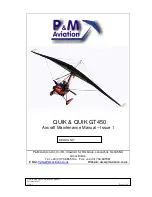
Quik & Quik GT450 Maintenance Manual
29
th
March 2007
Issue 1
Page 11 of 54
1.5. GROUND HANDLING
A flight has not been successfully and safely concluded until the engine has been stopped, the aircraft has
been securely parked and picketed or hangared, and the pilot and passenger have disembarked. Do not
make the mistake of losing concentration just because you have landed safely. Never taxi at more than
walking pace. Use the brakes gently. Remember to make sufficient allowance for the span of the aircraft
when manoeuvring in confined spaces. Always be ready to switch off the engine in the event of any
problem. Respect ground handling limitations and avoid taxiing in strong winds and gusty conditions. For
fixed wing pilots: remember the nose-wheel steering operates in the opposite direction to that which you are
used to. See section Aircraft Operating Instructions for further information
1.6 AIRSTRIP CRITERIA
Your airstrip should be smooth, flat, devoid of obstructions, clear of stones and other obstacles which may
damage the aircraft and more particularly the propeller. Short cut grass or tarmac are ideal surfaces. The
strip should be sufficiently long to allow for a straight ahead landing in the event of an engine failure on climb
out. Both the approach and the climb out zones should be free of any high obstructions like trees, pylons &
buildings, and ideally there should be some alternate landing fields in these zones to allow for safe landings
in the event of engine problems when landing or taking off. Airstrips surrounded by trees or other obstacles
should be avoided, particularly in windy conditions, since low-level turbulence and rotor are likely to be
present. Exercise great care when visiting other airstrips for the first time, since it is quite possible that they
are not suitable for safe Microlight operation.
1.7. SPECIAL HAZARDS
You should be aware of the following special hazards and it is your duty to point them out to passengers and
spectators:
Propellers
Rotating, and indeed even stationary propellers pose potential dangers. Rotating propellers are very hard to
see, so special attention should be made to keep persons, and especially children and pets, clear of the
aircraft once it has been started. Persons should never stand either in line with the arc of the propeller or
behind it since there is always a possibility that stones or other objects can be picked up and hurled at great
speed in any direction. In the event of a propeller strike close down the engine immediately and do not re-
start until you are satisfied that no structural damage has been done to the propeller or airframe. If any
damage is visible, do not fly until the damaged blade has been repaired or replaced and the engine has been
inspected for shock load damage.
If you do not wear a harness it could be
hazardous and failure to do so may result in
injury or death.
THE EXHAUST SYSTEM: Do not touch the exhaust while the engine is running or directly after it has been
shut down. It will be very hot and will inflict serious burns if touched. Keep items of clothing and the
aircraft's seat belts clear also. Inspect the entire exhaust system for cracks and damage before and after
each flight. Do not fly if there is any damage.
WARNING
!
WARNING
!
Содержание QUIK
Страница 14: ...Quik Quik GT450 Maintenance Manual 29th March 2007 Issue 1 Page 14 of 54 2 1 GENERAL ARRANGEMENT DRAWINGS...
Страница 15: ...Quik Quik GT450 Maintenance Manual 29th March 2007 Issue 1 Page 15 of 54...
Страница 53: ...Quik Quik GT450 Maintenance Manual 29th March 2007 Issue 1 Page 53 of 54...
Страница 54: ...Quik Quik GT450 Maintenance Manual 29th March 2007 Issue 1 Page 54 of 54...


























